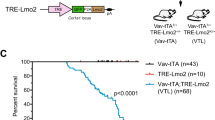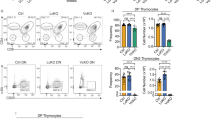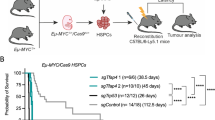Abstract
Arising from: N.-B. Woods, V. Bottero, M. Schmidt, C. von Kalle & I. M. Verma Nature 440, 1123 (2006); see also communication from Thrasher et al.; Woods et al. reply
The gene IL2RG encodes the γ-chain of the interleukin-2 receptor and is mutated in patients with X-linked severe combined immune deficiency (X-SCID). Woods et al.1 report the development of thymus tumours in a mouse model of X-SCID after correction by lentiviral overexpression of IL2RG and claim that these were caused by IL2RG itself. Here we find that retroviral overexpression of IL2RG in human CD34+ cells has no effect on T-cell development, whereas overexpression of the T-cell acute lymphoblastic leukaemia (T-ALL) oncogene LMO2 leads to severe abnormalities. Retroviral expression of IL2RG may therefore not be directly oncogenic — rather, the restoration of normal signalling by the interleukin-7 receptor to X-SCID precursor cells allows progression of T-cell development to stages that are permissive for the pro-leukaemic effects of ectopic LMO2.
Similar content being viewed by others
Main
The occurrence of leukaemia in three patients in a gene-therapy trial for X-SCID (refs 2–4) has highlighted an adverse effect of insertional mutagenesis as a delivery technique for the therapeutic gene. In our investigation, we expressed both LMO2 and IL2RG transgenes in the same retroviral vector that was used in the clinical gene-therapy trials; those trials found that retroviral integration of the corrective IL2RG occurred near the locus of the LMO2 oncogene5. We concluded that this integration may have upregulated the expression of LMO2 and triggered the leukaemia cases in the gene-therapy trials.
Woods et al. used a murine model in which stem cells from wild-type or mutant IL2RG−/− mice were transduced with very high amounts of human IL2RG by means of a lentiviral vector1. They found that these transplanted mice developed a high incidence of tumours. To the best of our knowledge, however, IL2RG has never been reported to act as an oncogene in human T-ALL, and murine studies should be interpreted with caution when extrapolating to humans. Although T-cell development is very similar in mice and humans at the genome-wide level6,7, there are differences in individual genes: for instance, mutant IL2RG−/− mice lack T, B and natural killer (NK) cells, whereas human X-SCID patients have normal numbers of B cells.
Mouse–human hybrid fetal thymus organ culture (FTOC) is often used to study human T-cell development ex vivo. In FTOC experiments, we found that LMO2-transduced cells expressed the early thymocyte marker CD1a less frequently than untransduced cells derived from the same culture (22% compared with 57%), whereas a higher proportion of LMO2-transduced cells retained the progenitor marker CD34 (12% compared with 2–4%, representative of five different FTOC experiments). Later, during T-cell development, this block was even more pronounced (58% of cells in the subsequent immature CD4 single-positive stage, compared with 22% in controls). These results indicate that progenitor cells ectopically expressing LMO2 are severely hampered in T-cell development.
The percentage of immature CD4 single-positive (37% compared with 38%) and the later CD4+CD8+ double-positive cells (6% compared with 9%) was similar in untransduced and IL2RG-transduced populations, indicating that retroviral-mediated expression of IL2RG does not affect T-cell development. LMO2-transduced cells developed normally into B, NK and myeloid cells.
The very high expression of lentiviral transgenic IL2RG in the transplanted mice studied by Woods et al.1 may have contributed to development of T-cell lymphomas. In contrast, IL2RG concentrations were slightly lower than normal in the human X-SCID trials after treatment using retroviral vectors. The phenotype of the mouse tumours is very immature and different from that of the T-ALL that occurred in the three X-SCID patients. Unfortunately, Woods et al. do not indicate whether the tumours were clonal, whether they expressed IL2RG, or whether JAK3 was activated; it is possible that the IL2RG gene might itself be mutated — for example, as a result of errors in lentiviral reverse transcription, but details of the insertion sites recovered are not given.
In our view, the retroviral-mediated expression of IL2RG in haematopoietic precursors does not represent a leukaemogenic event. This γ-chain is highly expressed in normal haematopoietic CD34+ precursors and during all stages of T-cell development, whereas LMO2 is only expressed in progenitor cells and the earliest thymocytes6. Furthermore, IL2RG expression in treated X-SCID patients is within the normal range5. Persistent activation of JAK3 was not detected in these patients, indicating that IL2RG function was normal in the setting of retroviral expression5.
Taken together, these observations argue against IL2RG acting as an oncogene in human gene therapy, although our experiments cannot rule out the possibility that a therapeutic transgene might provide an inappropriate growth stimulus when expressed at high dose or at an inappropriate time. Instead, it is likely that restored IL2RG expression allows T-cell development to progress to stages at which LMO2 would normally be completely downregulated but might contribute to leukaemogenesis if ectopically expressed.
References
Woods, N.-B., Bottero, V., Schmidt, M., von Kalle, C. & Verma, I. M. Nature 440, 1123 (2006).
Hacein-Bey-Abina, S. et al. N. Engl. J. Med. 348, 255–256 (2003).
Marshal, E. Science 299, 320 (2003).
Check, E. Nature 433, 561 (2005).
Hacein-Bey-Abina, S. et al. N. Engl. J. Med. 302, 415–419 (2003).
Dik, W. et al. J. Exp. Med. 201, 1715–1723 (2005).
Weerkamp, F., Pike-Overzet, K., & Staal, F. J. T. Trends Immunol. 27, 125–131 (2006).
Author information
Authors and Affiliations
Corresponding author
Rights and permissions
About this article
Cite this article
Pike-Overzet, K., de Ridder, D., Weerkamp, F. et al. Is IL2RG oncogenic in T-cell development?. Nature 443, E5 (2006). https://doi.org/10.1038/nature05218
Published:
Issue Date:
DOI: https://doi.org/10.1038/nature05218
This article is cited by
-
Thymocyte self-renewal and oncogenic risk in immunodeficient mouse models: relevance for human gene therapy clinical trials targeting haematopoietic stem cell populations?
Mammalian Genome (2018)
-
Gene Therapy for the Treatment of Primary Immune Deficiencies
Current Allergy and Asthma Reports (2016)
-
Gene Therapy for SCID
Current Pediatrics Reports (2015)
-
Retroviral Integrations in Gene Therapy Trials
Molecular Therapy (2012)
-
Induced pluripotent stem cells and severe combined immunodeficiency: merely disease modeling or potentially a novel cure?
Pediatric Research (2012)
Comments
By submitting a comment you agree to abide by our Terms and Community Guidelines. If you find something abusive or that does not comply with our terms or guidelines please flag it as inappropriate.



